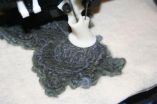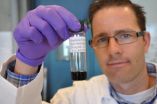(Press-News.org) PITTSBURGH—Soft and cuddly aren't words used to describe the plastic or metal things typically produced by today's 3D printers. But a new type of printer developed by Carnegie Mellon University and Disney Research Pittsburgh can turn wool and wool blend yarns into fabric objects that people might actually enjoy touching.
The device looks something like a cross between a 3D printer and a sewing machine and produces 3D objects made of a form of loose felt. Scott Hudson, a professor in CMU's Human-Computer Interaction Institute who developed the felting printer with Disney Research support, said the results are reminiscent of hand-knitted materials.
"I really see this material being used for things that are held close," Hudson said. "We're really extending the set of materials available for 3D printing and opening up new possibilities for what can be manufactured."
That could include apparel, accessories such as scarves and hats and even Teddy Bears. It also might be used to produce parts for so-called "soft robots" – robots designed to touch or be near people. Hudson will discuss the felting printer April 28 at the CHI Conference on Human Factors in Computing Systems in Toronto.
Like other 3D printers, Hudson's machine can make objects by working directly from computerized designs. It thus can be used for rapid prototyping of objects and to customize products.
In fact, the operation of the machine is similar to Fused Deposition Modeling, or FDM, the most common process used in low-end 3D printers. In a FDM printer, melted plastic is extruded in a thin line into a layer; subsequent layers are added to achieve the object's desired shape, with the layers adhering to each other as the plastic cools.
In the felting printer, however, the printer head feeds out yarn instead of lines of melted plastic. A barbed felting needle attached to the printer head then repeatedly pierces the yarn, dragging down individual fibers into the yarn in the layers below, entangling the fibers and bonding the layers together.
Hudson said the printer doesn't achieve the same dimensional accuracy as conventional 3D printers because the yarn is much thicker than the layers of plastic deposited in FDM printing. The felt also is not as strong as typical fabric, he noted, so if the soft objects are to be attached to a hard object, a layer of nylon mesh fabric must be incorporated during the printing process. This provides reinforcement to prevent the material from ripping away at the attachment point.
Hudson demonstrated techniques for bridging between the soft and hard materials, for manipulating the degree of stiffness in the soft objects and for incorporating electronic components.
These techniques require some assembly of objects because the printer now produces only fabric objects. But Hudson said it should be possible to design a printer that could produce both fabric and plastic elements in a single fabrication.
"A number of researchers are looking at mixed materials in 3D printing," he added. "That's one of the most interesting challenges now."
INFORMATION:
A video showing how the felting printer works and how it might be used is available online at http://www.disneyresearch.com/project/printed-teddy-bears/
About Carnegie Mellon University
Carnegie Mellon is a private, internationally ranked research university with programs in areas ranging from science, technology and business, to public policy, the humanities and the arts. More than 12,000 students in the university's seven schools and colleges benefit from a small student-to-faculty ratio and an education characterized by its focus on creating and implementing solutions for real problems, interdisciplinary collaboration and innovation. A global university, Carnegie Mellon has campuses in Pittsburgh, Pa., California's Silicon Valley and Qatar, and programs in Africa, Asia, Australia, Europe and Mexico.
About Disney Research
Disney Research is a network of research laboratories supporting The Walt Disney Company. Its purpose is to pursue scientific, and technological innovation to advance the company's broad media and entertainment efforts. Disney Research is managed by an internal Disney Research Council co-chaired by Disney-Pixar's Ed Catmull and Walt Disney Imagineering's Bruce Vaughn, and including the directors of the individual labs. It has facilities in Los Angeles, San Francisco, Pittsburgh, Boston and Zurich. Research topics include Computer Graphics, Video Processing, Computer Vision, Robotics, Radio and Antennas, Wireless Communications, Human-Computer Interaction, Displays, Data Mining, Machine Learning and Behavioral Sciences.
Carnegie Mellon-Disney researcher invents 3-D printing technique for making cuddly stuff
Printer uses needle to turn layers of wool yarn into loose felt
2014-04-29
ELSE PRESS RELEASES FROM THIS DATE:
Beyond graphene: Controlling properties of 2-D materials
2014-04-29
The isolation of graphene at the University in 2004 led to the discovery of many other 2D crystals. While graphene has an unrivalled set of superlatives, these crystals cover a large range of properties: from the most conductive to isolating, from transparent to optically active.
The next step is to combine several of these crystals in a 3D stack. This way, one can create 'heterostructures' with novel functionalities – capable of delivering applications as yet beyond the imagination of scientists and commercial partners.
The first examples of such heterostructures already ...
Scripps Florida scientists reveal molecular secrets behind resveratrol's health benefits
2014-04-29
JUPITER, FL, April 29, 2014 – Resveratrol has been much in the news as the component of grapes and red wine associated with reducing "bad cholesterol," heart disease and some types of cancer. Also found in blueberries, cranberries, mulberries, peanuts and pistachios, resveratrol is associated with beneficial health effects in aging, inflammation and metabolism.
Scientists from the Florida campus of The Scripps Research Institute (TSRI) have now identified one of the molecular pathways that resveratrol uses to achieve its beneficial action. They found that resveratrol ...
Tapah through infrared satellite eyes: Now a typhoon
2014-04-29
Tropical Storm Tapah strengthened since April 28 and early on April 29, the storm reached typhoon strength. From its orbit in space, NASA's Aqua satellite zoomed over Tapah and the AIRS instrument captured infrared data on the storm that showed the location of its strongest thunderstorms.
The U.S. National Weather Service in Guam noted that a tropical storm warning and a typhoon watch continues for Alamagan and Pagan. For details on the advisory, visit: http://www.prh.noaa.gov/data/GUM/HLSPQ1
The Atmospheric Infrared Sounder (AIRS) instrument that flies aboard NASA's ...
Graphene not all good
2014-04-29
RIVERSIDE, Calif. — In a first-of-its-kind study of how a material some think could transform the electronics industry moves in water, researchers at the University of California, Riverside Bourns College of Engineering found graphene oxide nanoparticles are very mobile in lakes or streams and therefore likely to cause negative environmental impacts if released.
Graphene oxide nanoparticles are an oxidized form of graphene, a single layer of carbon atoms prized for its strength, conductivity and flexibility. Applications for graphene include everything from cell phones ...
Rice U. study: How state ownership hampered entrepreneurship in Chinese companies
2014-04-29
HOUSTON – (April 29, 2014) – For state-owned companies in China, the significant detriment in employing innovation may be linked to the company's ownership structure, according to a new study on Chinese entrepreneurship by Chinese business experts at Rice University, the University of Hong Kong, Texas Christian University, Jilin University and Shantou University.
The researchers found that the more equity the state owned of a company, the less likely the company was to engage in strategic entrepreneurship (investing in research and development and other innovations) to ...
Anti-smoking TV ads should use anger, Dartmouth-Cornell study suggests
2014-04-29
Anti-smoking television advertisements that appeal to viewers' emotions are more persuasive when they use anger rather than sadness, a Dartmouth-Cornell study suggests.
The study appears in the Journal of Health Communication. A PDF is available on request.
Previous studies have shown emotional expression is a crucial part of persuasion, and that audience members' perceptions of emotions affect their attitudes and behaviors. Previous research also has shown anti-smoking TV ads that convey negative emotions such as anger and sadness are more effective than non-emotional ...
'Feel good' factor higher when you own, not just use, luxury items
2014-04-29
It means more to people to own a luxury product or brand than to have the privilege of simply using one. Just using an affordable luxury item you don't own can, in fact, dampen the feel good factor that normally surrounds such products, say Liselot Hudders and Mario Pandelaere of Ghent University in Belgium. The research was published in Springer's journal Applied Research in Quality of Life.
To test the link between luxury consumption and subjective well-being, the researchers presented 307 study participants with luxury and ordinary versions of either a durable pen, ...
Solving a mystery of thermoelectrics
2014-04-29
CAMBRIDGE, Mass-- Materials that can be used for thermoelectric devices — those that turn a temperature difference into an electric voltage — have been known for decades. But until now there has been no good explanation for why just a few materials work well for these applications, while most others do not. Now researchers at MIT and elsewhere say they have finally found a theoretical explanation for the differences, which could lead to the discovery of new, improved thermoelectric materials.
The findings — by MIT graduate student Sangyeop Lee; Gang Chen, the Carl Richard ...
UNC researchers discover 'master regulator' role for little-known protein in cancer cells
2014-04-29
CHAPEL HILL, N.C. – Researchers in the UNC School of Medicine found that the protein DAZAP1 plays a key role in the regulation of many genes through a process known as alternative splicing, and when highly expressed in cancer cell line experiments, DAZAP1 was shown to inhibit several types of cancer cells from dividing and moving.
The discovery, published in the journal Nature Communications, marks the first time this little-known protein has been characterized in relation to cancer development and tumor growth.
"If you knock down DAZAP1, then most of the genes involved ...
Study yields potential drug targets for preeclampsia patients
2014-04-29
Preeclampsia, the most common complication of pregnancy, is a major cause of premature delivery and both maternal and fetal death, yet what causes the syndrome remains unclear. A new study indicates that molecules that send detrimental signals are abundant in certain tissues in preeclampsia patients. The study also documented some of the complications experienced by babies born to mothers with preeclampsia.
"Preeclampsia is a multifaceted complication found uniquely in the pregnant patient and one that has puzzled scientists for years," says the leader of the study, ...
LAST 30 PRESS RELEASES:
Groundbreaking discovery turns household plastic recycling into anti-cancer medication
Blocking a key inflammatory pathway improves liver structure and vascular function in cirrhosis, study finds
Continuous spread: Raccoon roundworm detected in nine European countries
HKUST Engineering researchers developed a novel photodetector to enhance the performance of on-chip light monitoring
Strategic river sensors could have forewarned of Texas Camp flood disaster
Drone sampling of whale breath reveals first evidence of potentially deadly virus in Arctic
Roman soldiers defending Hadrian’s Wall infected by parasites, study finds
Pinochet’s prisoners were tormented with music but still found solace in it, a new book reveals
Fertility remains high in rural Tanzania despite access to family planning
AI-assisted device can improve autism care access
Kinetic careers
Uncovering how parasitic plants avoid attacking themselves to improve crop resistance
Nanoparticle vaccine strategy could protect against Ebola and other deadly filoviruses
Study finds brain care score can predict risk of stroke across racial groups
Key lung immune cells can intensify allergic reactions
Do hormones explain why women experience more gut pain?
New materials conduct ions in solids as easily as in liquids
Breakthrough of the Year: Renewable energy begins to eclipse fossil fuel-based sources
LLM use is reshaping scientific enterprise by increasing output, reducing quality and more
Introducing LightGen, a chip for ultra-fast, ultra-efficient generative AI
Astronomers see fireworks from violent collisions around nearby star
ACC/AHA issue new guideline on managing congenital heart disease in adults
Cosmic crash caught on camera
Is talented youth nurtured the wrong way? New study shows: top performers develop differently than assumed
Ants: An untapped resource in the development of antibiotics?
Archaeologists use AI to create prehistoric video game
Mitochondria migrate toward the cell membrane in response to high glucose levels
Tiny viral switch offers hope against drug-resistant bacteria
Most parents aware of early peanut introduction guidelines, but confused about details
HPV vaccine can protect against severe lesions of the vulva and vagina
[Press-News.org] Carnegie Mellon-Disney researcher invents 3-D printing technique for making cuddly stuffPrinter uses needle to turn layers of wool yarn into loose felt



